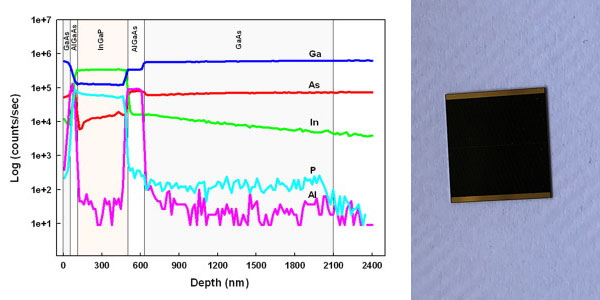GaAs based multi junction solar cell is the most competitive new generation solar cell in the world. It meets the requirements of aerospace vehicles for high performance and long life of space main power supply. Traditional lattice matched triple junction GaAs solar cells have limited room for efficiency improvement. In order to further improve the performance of such cells, four junction (or more) multi junction stacked solar cells can be developed by carefully dividing the solar spectrum. Therefore, this paper takes the band gap matched four junction solar cell GaInP (1.90ev) / GaAs (1.41ev) / InGaAs (1eV) / InGaAs (0.7eV) as the research object, and makes theoretical simulation and optimization by using APSYS software developed by crosslight company.

(1)The performance of the sub cell is simulated, and the effects of the doping concentration and thickness of the emission region and the base region and the minority carrier lifetime on the performance of the cell are analyzed. affecting the conversion efficiency of the cell; The doping concentration in the emission region has a significant effect on the voltage and current, resulting in an inflection point in the change of efficiency; The minority carrier lifetime significantly affects the performance parameters of the cell.
(2) According to the basic element of multi junction cell design - current matching, the current matching design of GaInP / GaAs and in0.3ga0.7as/in0.58ga0.42as double junction cells is carried out.
(3) The performance simulation and optimization of the full structure four junction solar cell are completed, and the simulation results are as follows: VOC = 3540mv, JSC = 20.08 MA / cm2, FF = 0.88, eff = 47.8%; The preliminary practice of the structural design is carried out, and the experimental results of VOC = 3301mv, JSC = 17.33 MA / cm2, FF = 0.834, eff = 34.87% are obtained, which well verifies the correctness and feasibility of the theoretical simulation and design.
The band gaps of GaInP / GaAs / InGaAs / Ge 4-j series solar cells are 1.8, 1.4, 1.0 and 0.7 EV, respectively. In order to match the current between the sub cells, a tunnel junction is used to connect the sub cells. The characteristics of the tunnel junction, the materials used in the tunnel junction, the compensation of the tunnel junction to the overall cell characteristics, the influence of the tunnel junction on the sub cell current density and the improvement of efficiency are discussed.